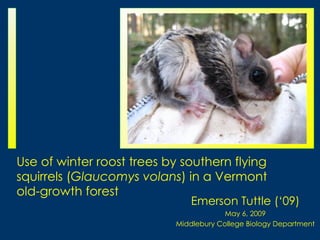
Thesis presentation
- 1. Use of winter roost trees by southern flying squirrels (Glaucomys volans) in a Vermont old-growth forest Emerson Tuttle (‘09) May 6, 2009 Middlebury College Biology Department
- 2. Flying squirrels: Genus Glaucomys • Unique nocturnal rodents • Two species - Northern (G. sabrinus) - Weight: 75-140g - Southern (G. volans) - Weight: 46-85g • Consumers of hypogeous mycorrhizal fungi and hard mast, respectively • Competition? - Little evidence of local sympatry Top: Ralph Palmer, www.flickr.com; Bottom: Phil Myers, www.discoverlife.org
- 3. Flying squirrels: Genus Glaucomys • Northern Appalachian region one of the only areas where the species overlap in range • Associated with old- growth forest structure • Influence on forest composition as dispersers • Listed by the Vermont Fish & Wildlife Department as a species of conservation concern in the state Don E. Wilson, http://www.discoverlife.org
- 4. Study Questions • What is the density of flying squirrels in a Vermont old-growth forest? 2) What characterizes late fall/winter roost sites employed by flying squirrels? 3) What are the habitat preferences of southern and northern flying squirrels, and how do their distributions overlap?
- 5. Study Site Battell Research Forest http://www.vermont-map.org/detailed.htm
- 6. Methods: Live-Trapping • Two different types of trap were affixed to 60 haphazardly selected trees • Traps baited one hour before sunset with a mixture of peanut butter, oats, and apples • 8-12 cotton balls included for bedding material • All traps checked the next morning for captures A trapping station – the smaller Sherman trap rests atop a platform facing the tree trunk with the larger Tomahawk resting below.
- 7. Methods: Mark-recapture •Bag ‘em • Identify sex and species • Mark back with a unique hair dye design •Release the animal That is if it wants to leave…
- 8. Glaucomys capture success • Trap-nights: 1489 • Total flying squirrel caught: 67 - Southern: 40 - Northern: 10 - Unidentified: 17 • Trap success: 4.50% - Sherman success: 6.90% - 55 captures / 797 trap-nights - Tomahawk success: 1.73% -12 captures / 692 trap-nights A southern flying squirrel peering out of a Sherman trap
- 9. Results: Mark-recapture • 20 individuals marked • 10 different individuals Maximum Minimum recaptured on 18 total Density Density occasions (animals/ha) (animals/ha) • Lincoln-Peterson method: Total Flying population size estimate 3.8 ± 1.0 2.3 ± 0.6 Squirrels Northern F.s. 0.5 ± 0.2 0.3 ± 0.1 Southern F.s. 2.7 ± 0.7 1.6 ± 0.4 Animal density estimates based on literature values of minimum (100 m) and maximum (160 m) effective home range radii of flying squirrels
- 10. Differential trap success • Clusters of traps had higher capture rates -Northern Cluster 8.3% capture success -Central Cluster 13.1% capture success -Southern Cluster 6.2% capture success • Is a cluster of high capture rate due simply to one individual?
- 11. Study Questions • What is the density of flying squirrels in a Vermont old-growth forest? 2) What characterizes late fall/winter roost sites employed by flying squirrels? 3) What are the habitat preferences of southern and northern flying squirrels, and how do their distributions overlap?
- 12. Locomotion • Flying squirrels do not fly, they glide… …but what does that even mean? http://aparadigmshift.files.wordpress.com/2009/02/nfsquir.jpg
- 13. Locomotion
- 14. Locomotion
- 15. Locomotion
- 16. Locomotion
- 17. Roosting ecology • Flying squirrels employ existing tree cavities and external nests as diurnal refuges • Winter is an energetically costly period for maintaining body heat http://www.jennifermarohasy.com/blog/archives/Ann %20Novek_Siberian%20Squirrel_lendorav5.jpg • Flying squirrels engage in group nesting behavior of 4-7 individuals to reduce heat loss http://www.ealt.ca/media/imagic/Betty_Fisher_flying_squirrel_babies_in_nest_h ole.jpg
- 18. Methods: Radio-telemetry • Six southern flying squirrels were fitted with radio collars • For proper fitting, animals were anesthetized in the field with isoflurane • Tracking to diurnal dens occurred throughout the late fall and winter months
- 19. Results: Roost trees •• The overstory composition was not Roost trees were larger at the base than randomroost sites=and random different at trees (p 0.001) sites (all p > 0.519)
- 20. Roost sites in relation to trap success • Roosting trees not always in close proximity with foraging regions • Foraging regions seemingly associated with winter tree cover
- 21. Evidence of shared roosts • Maple snag - 4 male individuals - visible midden at base • Pine snag - 2 male individuals
- 22. Study Questions • What is the density of flying squirrels in a Vermont old-growth forest? 2) What characterizes late fall/winter roost sites employed by flying squirrels? 3) What are the habitat preferences of southern and northern flying squirrels, and how do their distributions overlap?
- 23. Species movement patterns • Group roosting squirrels exhibit pronounced home range overlap • Shared winter foraging grounds? • Only one recaptured northern flying squirrel
- 24. Conclusions • Population dominated by the smaller, more aggressive southern flying squirrel • Roost trees were larger than random trees, but canopy cover near roosts was similar – Selection of winter roost sites based on target tree characteristics • Group roosting observed in a distinct tree motif – Snapped snag; cavities at apex of stem • Foraging sites show marked overlap between individuals
- 25. Future directions • Dispersal patterns in early spring and roost tree use in warmer seasons? • Selection criteria for spatial foraging preference? • Genetic analysis of relatedness between group-nesting individuals? • Role of Strongyloides robustus in determining flying squirrel population dynamics?
- 26. Acknowledgements Steve Trombulak Joanna Shipley Mark Spritzer, Helen Young Eco/Evo Bio lunch group Bill Hegman Peter and Cathy Tuttle Vicki Major, Sarah Froebel Charlie Hofmann, Chris Free, Zöe Sheldon, Tripp Burwell, Catherine Timmins, Steve Heck, Kei Katsura, Greg Larsen, Andrew Locke, Mithra Harivandi Matt Westman, Ian Evans, Jordan Valen Funding Lake Champlain Research Consortium Senior Research Fellowship
- 27. Questions?